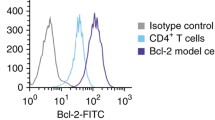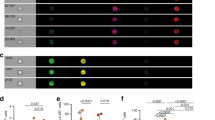Abstract
During antiretroviral therapy (ART), HIV-1 persists as a latent reservoir in CD4+ T cell subsets in central (TCM), transitional (TTM) and effector memory (TEM) CD4+ T cells. Understanding the mechanisms that support HIV-1 latency in each of these subsets is essential to the identification of cure strategies to eliminate them. Due to the very low frequency of latently infected cells in vivo, model systems that can accurately reflect the heterogenous population of HIV-1 infected cells are a critical component in HIV cure discoveries. Here, we describe a novel primary cell-based model of HIV-1 latency that recapitulates the complex dynamics of the establishment and maintenance of the latent reservoir in different memory T cell subsets. The latency and reversion assay (LARA ) culture conditions uniquely retain phenotypically and transcriptionally distinct memory CD4+ T cell subsets that allow in a single assay to assess LRA activity in each memory subset and differential examination of the dynamics of HIV latency reversal.
Access this chapter
Tax calculation will be finalised at checkout
Purchases are for personal use only
Similar content being viewed by others
References
Kulpa DA, Chomont N (2015) HIV persistence in the setting of antiretroviral therapy: when, where and how does HIV hide? J Virus Erad 1(2):59–66
Westera L, Drylewicz J, den Braber I, Mugwagwa T, van der Maas I, Kwast L, Volman T, van de Weg-Schrijver EH, Bartha I, Spierenburg G, Gaiser K, Ackermans MT, Asquith B, de Boer RJ, Tesselaar K, Borghans JA (2013) Closing the gap between T-cell life span estimates from stable isotope-labeling studies in mice and humans. Blood 122(13):2205–2212. https://doi.org/10.1182/blood-2013-03-488411
Sacha JB, Ndhlovu LC (2016) Strategies to target non-T-cell HIV reservoirs. Curr Opin HIV AIDS 11(4):376–382. https://doi.org/10.1097/COH.0000000000000283
Kandathil AJ, Sugawara S, Balagopal A (2016) Are T cells the only HIV-1 reservoir? Retrovirology 13(1):86. https://doi.org/10.1186/s12977-016-0323-4
Llewellyn GN, Alvarez-Carbonell D, Chateau M, Karn J, Cannon PM (2018) HIV-1 infection of microglial cells in a reconstituted humanized mouse model and identification of compounds that selectively reverse HIV latency. J Neurovirol 24(2):192–203. https://doi.org/10.1007/s13365-017-0604-2
Sadowski I, Hashemi FB (2019) Strategies to eradicate HIV from infected patients: elimination of latent provirus reservoirs. Cell Mol Life Sci 76(18):3583–3600. https://doi.org/10.1007/s00018-019-03156-8
Chomont N, El-Far M, Ancuta P, Trautmann L, Procopio FA, Yassine-Diab B, Boucher G, Boulassel MR, Ghattas G, Brenchley JM, Schacker TW, Hill BJ, Douek DC, Routy JP, Haddad EK, Sekaly RP (2009) HIV reservoir size and persistence are driven by T cell survival and homeostatic proliferation. Nat Med 15(8):893–900. https://doi.org/10.1038/nm.1972
Chomont N, DaFonseca S, Vandergeeten C, Ancuta P, Sekaly RP (2011) Maintenance of CD4+ T-cell memory and HIV persistence: keeping memory, keeping HIV. Curr Opin HIV AIDS 6(1):30–36. https://doi.org/10.1097/COH.0b013e3283413775
Buzon MJ, Sun H, Li C, Shaw A, Seiss K, Ouyang Z, Martin-Gayo E, Leng J, Henrich TJ, Li JZ, Pereyra F, Zurakowski R, Walker BD, Rosenberg ES, Yu XG, Lichterfeld M (2014) HIV-1 persistence in CD4+ T cells with stem cell-like properties. Nat Med 20(2):139–142. https://doi.org/10.1038/nm.3445
Bacchus C, Cheret A, Avettand-Fenoel V, Nembot G, Melard A, Blanc C, Lascoux-Combe C, Slama L, Allegre T, Allavena C, Yazdanpanah Y, Duvivier C, Katlama C, Goujard C, Seksik BC, Leplatois A, Molina JM, Meyer L, Autran B, Rouzioux C, group OAs (2013) A single HIV-1 cluster and a skewed immune homeostasis drive the early spread of HIV among resting CD4+ cell subsets within one month post-infection. PLoS One 8(5):e64219. https://doi.org/10.1371/journal.pone.0064219
Yukl SA, Shergill AK, Ho T, Killian M, Girling V, Epling L, Li P, Wong LK, Crouch P, Deeks SG, Havlir DV, McQuaid K, Sinclair E, Wong JK (2013) The distribution of HIV DNA and RNA in cell subsets differs in gut and blood of HIV-positive patients on ART: implications for viral persistence. J Infect Dis 208(8):1212–1220. https://doi.org/10.1093/infdis/jit308
Saez-Cirion A, Bacchus C, Hocqueloux L, Avettand-Fenoel V, Girault I, Lecuroux C, Potard V, Versmisse P, Melard A, Prazuck T, Descours B, Guergnon J, Viard JP, Boufassa F, Lambotte O, Goujard C, Meyer L, Costagliola D, Venet A, Pancino G, Autran B, Rouzioux C, Group AVS (2013) Post-treatment HIV-1 controllers with a long-term virological remission after the interruption of early initiated antiretroviral therapy ANRS VISCONTI study. PLoS Pathog 9(3):e1003211. https://doi.org/10.1371/journal.ppat.1003211
Castro-Gonzalez S, Colomer-Lluch M, Serra-Moreno R (2018) Barriers for HIV cure: the latent reservoir. AIDS Res Hum Retrovir 34(9):739–759. https://doi.org/10.1089/AID.2018.0118
Shan L, Siliciano RF (2013) From reactivation of latent HIV-1 to elimination of the latent reservoir: the presence of multiple barriers to viral eradication. BioEssays 35(6):544–552. https://doi.org/10.1002/bies.201200170
Hill AL (2018) Mathematical models of HIV latency. Curr Top Microbiol Immunol 417:131–156. https://doi.org/10.1007/82_2017_77
Lucic B, Lusic M (2016) Connecting HIV-1 integration and transcription: a step toward new treatments. FEBS Lett 590(13):1927–1939. https://doi.org/10.1002/1873-3468.12226
Sgarbanti M, Battistini A (2013) Therapeutics for HIV-1 reactivation from latency. Curr Opin Virol 3(4):394–401. https://doi.org/10.1016/j.coviro.2013.06.001
Thorlund K, Horwitz MS, Fife BT, Lester R, Cameron DW (2017) Landscape review of current HIV ‘kick and kill’ cure research - some kicking, not enough killing. BMC Infect Dis 17(1):595. https://doi.org/10.1186/s12879-017-2683-3
Margolis DM, Archin NM (2017) Proviral latency, persistent human immunodeficiency virus infection, and the development of latency reversing agents. J Infect Dis 215(suppl_3):S111–S118. https://doi.org/10.1093/infdis/jiw618
Kim Y, Anderson JL, Lewin SR (2018) Getting the "kill" into "shock and kill": strategies to eliminate latent HIV. Cell Host Microbe 23(1):14–26. https://doi.org/10.1016/j.chom.2017.12.004
Crooks AM, Bateson R, Cope AB, Dahl NP, Griggs MK, Kuruc JD, Gay CL, Eron JJ, Margolis DM, Bosch RJ, Archin NM (2015) Precise quantitation of the latent HIV-1 reservoir: implications for eradication strategies. J Infect Dis 212(9):1361–1365. https://doi.org/10.1093/infdis/jiv218
Spina CA, Anderson J, Archin NM, Bosque A, Chan J, Famiglietti M, Greene WC, Kashuba A, Lewin SR, Margolis DM, Mau M, Ruelas D, Saleh S, Shirakawa K, Siliciano RF, Singhania A, Soto PC, Terry VH, Verdin E, Woelk C, Wooden S, Xing S, Planelles V (2013) An in-depth comparison of latent HIV-1 reactivation in multiple cell model systems and resting CD4+ T cells from aviremic patients. PLoS Pathog 9(12):e1003834. https://doi.org/10.1371/journal.ppat.1003834
Xing S, Bullen CK, Shroff NS, Shan L, Yang HC, Manucci JL, Bhat S, Zhang H, Margolick JB, Quinn TC, Margolis DM, Siliciano JD, Siliciano RF (2011) Disulfiram reactivates latent HIV-1 in a Bcl-2-transduced primary CD4+ T cell model without inducing global T cell activation. J Virol 85(12):6060–6064. https://doi.org/10.1128/JVI.02033-10
Rasmussen TA, Lewin SR (2016) Shocking HIV out of hiding: where are we with clinical trials of latency reversing agents? Curr Opin HIV AIDS 11(4):394–401. https://doi.org/10.1097/COH.0000000000000279
Spivak AM, Planelles V (2018) Novel latency reversal agents for HIV-1 cure. Annu Rev Med 69:421–436. https://doi.org/10.1146/annurev-med-052716-031710
Cyster JG (2005) Chemokines, sphingosine-1-phosphate, and cell migration in secondary lymphoid organs. Annu Rev Immunol 23:127–159. https://doi.org/10.1146/annurev.immunol.23.021704.115628
Pepper M, Jenkins MK (2011) Origins of CD4(+) effector and central memory T cells. Nat Immunol 12(6):467–471
Riou C, Yassine-Diab B, Van Grevenynghe J, Somogyi R, Greller LD, Gagnon D, Gimmig S, Wilkinson P, Shi Y, Cameron MJ, Campos-Gonzalez R, Balderas RS, Kelvin D, Sekaly RP, Haddad EK (2007) Convergence of TCR and cytokine signaling leads to FOXO3a phosphorylation and drives the survival of CD4+ central memory T cells. J Exp Med 204(1):79–91. https://doi.org/10.1084/jem.20061681
Macallan DC, Wallace D, Zhang Y, De Lara C, Worth AT, Ghattas H, Griffin GE, Beverley PC, Tough DF (2004) Rapid turnover of effector-memory CD4(+) T cells in healthy humans. J Exp Med 200(2):255–260. https://doi.org/10.1084/jem.20040341
Lee B, Sharron M, Montaner LJ, Weissman D, Doms RW (1999) Quantification of CD4, CCR5, and CXCR4 levels on lymphocyte subsets, dendritic cells, and differentially conditioned monocyte-derived macrophages. Proc Natl Acad Sci U S A 96(9):5215–5220
Lees JR, Farber DL (2010) Generation, persistence and plasticity of CD4 T-cell memories. Immunology 130(4):463–470. https://doi.org/10.1111/j.1365-2567.2010.03288.x
Kulpa DA, Talla A, Brehm JH, Ribeiro SP, Yuan S, Bebin-Blackwell AG, Miller M, Barnard R, Deeks SG, Hazuda D, Chomont N, Sekaly RP (2019) Differentiation into an effector memory phenotype potentiates HIV-1 latency reversal in CD4(+) T cells. J Virol 93(24):e00969-19. https://doi.org/10.1128/JVI.00969-19
Kehrl JH, Wakefield LM, Roberts AB, Jakowlew S, Alvarez-Mon M, Derynck R, Sporn MB, Fauci AS (1986) Production of transforming growth factor beta by human T lymphocytes and its potential role in the regulation of T cell growth. J Exp Med 163(5):1037–1050
Tiemessen MM, Kunzmann S, Schmidt-Weber CB, Garssen J, Bruijnzeel-Koomen CA, Knol EF, van Hoffen E (2003) Transforming growth factor-beta inhibits human antigen-specific CD4+ T cell proliferation without modulating the cytokine response. Int Immunol 15(12):1495–1504
Letterio JJ, Roberts AB (1998) Regulation of immune responses by TGF-beta. Annu Rev Immunol 16:137–161. https://doi.org/10.1146/annurev.immunol.16.1.137
Zhang X, Giangreco L, Broome HE, Dargan CM, Swain SL (1995) Control of CD4 effector fate: transforming growth factor beta 1 and interleukin 2 synergize to prevent apoptosis and promote effector expansion. J Exp Med 182(3):699–709
Cerwenka A, Kovar H, Majdic O, Holter W (1996) Fas- and activation-induced apoptosis are reduced in human T cells preactivated in the presence of TGF-beta 1. J Immunol 156(2):459–464
Wang FX, Xu Y, Sullivan J, Souder E, Argyris EG, Acheampong EA, Fisher J, Sierra M, Thomson MM, Najera R, Frank I, Kulkosky J, Pomerantz RJ, Nunnari G (2005) IL-7 is a potent and proviral strain-specific inducer of latent HIV-1 cellular reservoirs of infected individuals on virally suppressive HAART. J Clin Invest 115(1):128–137. https://doi.org/10.1172/JCI22574
Vandergeeten C, Fromentin R, DaFonseca S, Lawani MB, Sereti I, Lederman MM, Ramgopal M, Routy JP, Sekaly RP, Chomont N (2013) Interleukin-7 promotes HIV persistence during antiretroviral therapy. Blood 121(21):4321–4329. https://doi.org/10.1182/blood-2012-11-465625
He T, Brocca-Cofano E, Policicchio BB, Sivanandham R, Gautam R, Raehtz KD, Xu C, Pandrea I, Apetrei C (2016) Cutting edge: T regulatory cell depletion reactivates latent simian immunodeficiency virus (SIV) in controller macaques while boosting SIV-specific T lymphocytes. J Immunol 197(12):4535–4539. https://doi.org/10.4049/jimmunol.1601539
Ebert EC (1999) Inhibitory effects of transforming growth factor-beta (TGF-beta) on certain functions of intraepithelial lymphocytes. Clin Exp Immunol 115(3):415–420
Sahu GK, Lee K, Ji J, Braciale V, Baron S, Cloyd MW (2006) A novel in vitro system to generate and study latently HIV-infected long-lived normal CD4+ T-lymphocytes. Virology 355(2):127–137
Tyagi M, Pearson RJ, Karn J (2010) Establishment of HIV latency in primary CD4+ cells is due to epigenetic transcriptional silencing and P-TEFb restriction. J Virol 84(13):6425–6437. https://doi.org/10.1128/JVI.01519-09
Khattar M, Miyahara Y, Schroder PM, Xie A, Chen W, Stepkowski SM (2014) Interleukin-21 is a critical regulator of CD4 and CD8 T cell survival during priming under Interleukin-2 deprivation conditions. PLoS One 9(1):e85882. https://doi.org/10.1371/journal.pone.0085882
Vandergeeten C, Fromentin R, Merlini E, Lawani MB, DaFonseca S, Bakeman W, McNulty A, Ramgopal M, Michael N, Kim JH, Ananworanich J, Chomont N (2014) Cross-clade ultrasensitive PCR-based assays to measure HIV persistence in large-cohort studies. J Virol 88(21):12385–12396. https://doi.org/10.1128/JVI.00609-14
Procopio FA, Fromentin R, Kulpa DA, Brehm JH, Bebin AG, Strain MC, Richman DD, O’Doherty U, Palmer S, Hecht FM, Hoh R, Barnard RJ, Miller MD, Hazuda DJ, Deeks SG, Sekaly RP, Chomont N (2015) A novel assay to measure the magnitude of the inducible viral reservoir in HIV-infected individuals. EBioMedicine 2(8):874–883. https://doi.org/10.1016/j.ebiom.2015.06.019
Author information
Authors and Affiliations
Corresponding author
Editor information
Editors and Affiliations
Rights and permissions
Copyright information
© 2022 Springer Science+Business Media, LLC, part of Springer Nature
About this protocol
Cite this protocol
Bergstresser, S., Kulpa, D.A. (2022). TGF-β Signaling Supports HIV Latency in a Memory CD4+ T Cell Based In Vitro Model. In: Poli, G., Vicenzi, E., Romerio, F. (eds) HIV Reservoirs. Methods in Molecular Biology, vol 2407. Humana, New York, NY. https://doi.org/10.1007/978-1-0716-1871-4_6
Download citation
DOI: https://doi.org/10.1007/978-1-0716-1871-4_6
Published:
Publisher Name: Humana, New York, NY
Print ISBN: 978-1-0716-1870-7
Online ISBN: 978-1-0716-1871-4
eBook Packages: Springer Protocols




